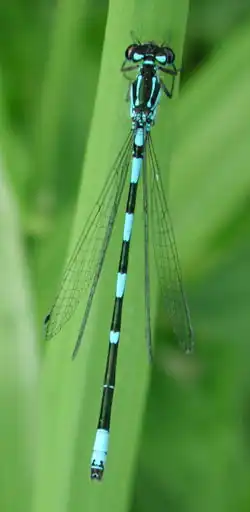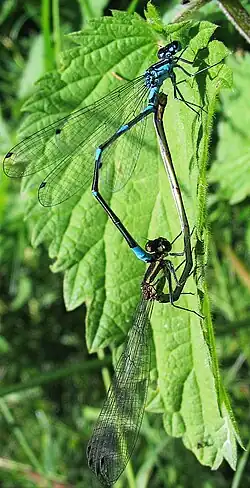Variable damselfly
| Variable damselfly | |
|---|---|
_male.jpg)
| |
| Male, shoulder stripe just broken, UK | |
_female_dark_form_Estonia.jpg)
| |
| Female, dark form, Estonia | |
| Scientific classification | |
| Kingdom: | Animalia |
| Phylum: | Arthropoda |
| Class: | Insecta |
| Order: | Odonata |
| Suborder: | Zygoptera |
| Family: | Coenagrionidae |
| Genus: | Coenagrion |
| Species: | C. pulchellum
|
| Binomial name | |
| Coenagrion pulchellum (Vander Linden, 1825)
| |
The variable damselfly or variable bluet (Coenagrion pulchellum) is a European damselfly. Despite its name, it is not the only blue damselfly prone to variable patterning.
Its behaviour is much like that of the azure damselfly; it usually stays close to vegetation. Immatures are often found in adjacent meadows or uncut grassy areas.
Description
The male variable damselfly has a distinctive "wine glass" marking on the second segment of the abdomen. This is a black U-shaped mark with a black line joining the segment's narrow terminal black band.[1] (This distinguishes it from the azure damselfly which has the U-shape but no line connecting it to the terminal band.)[1]
- Male forms
-
 Male
Male
S9 virtually unmarked -
_male_3.jpg) Male, shoulder stripe unbroken
Male, shoulder stripe unbroken -
_male_2.jpg) Male, shoulder stripe broken
Male, shoulder stripe broken -
_mating_Estonia.jpg) mating, with female blue form
mating, with female blue form -
 mating, with young adult female blue form
mating, with young adult female blue form
- Female forms
-
_immature_female_blue_form_Estonia.jpg) immature female, blue form
immature female, blue form -
_young_adult_female_blue_form_Estonia.jpg) young adult female blue form
young adult female blue form -
_female_dark_form_2_Estonia.jpg) adult female, dark form
adult female, dark form
Distribution
The variable damselfly occurs throughout Europe. Scattered and uncommon in mainland Britain but widespread and common in Ireland.[2]
References
- ^ a b Brooks, Steve (1997). Field Guide to the Dragonflies and Damselflies of Great Britain and Ireland. British Wildlife Publishing. ISBN 0-9531399-0-5.
- ^ "Variable Damselfly". British Dragonfly Society. Retrieved 27 May 2011.
External links